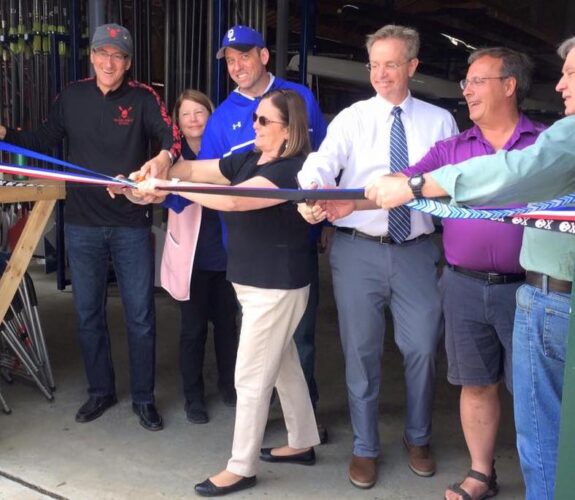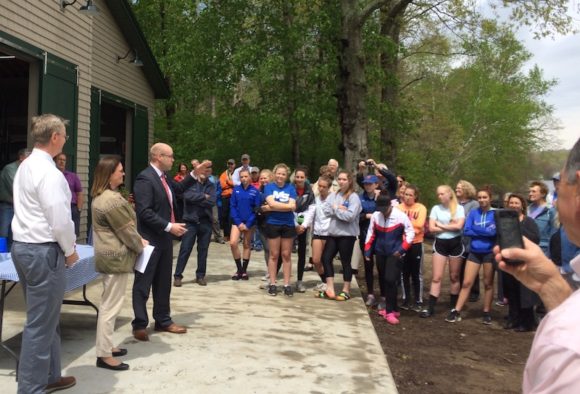
More than 100 people gathered Saturday morning at Hains Park on the shores of Rogers Lake to join a ceremony to dedicate the recently completed Fred Emerson Boathouse. All joined by a love of rowing, they were there to celebrate the official opening of the boathouse, which is the new home for boats owned by Lyme-Old Lyme Schools and the Old Lyme Rowing Club/Blood Street Sculls.
Old Lyme Rowing Association/Blood Street Sculls President Greg Hack spoke to the assembled crowd expressing thanks to many individuals and organizations saying, “On behalf of the over 150 athletes who will row on Rogers Lake this year, I would like to express how thrilled we are that the new Boathouse is now complete. We all feel a deep sense of gratitude to the people of the Town of Old Lyme, and to the State of Connecticut, for their support throughout this project.”
Construction of the boathouse was initially funded by a Small Town Economic Assistance Program (STEAP) grant for $478,000, which was awarded in July 2013, and then subsequently Old Lyme residents approved a request from their board of selectmen in October 2014 for an additional $405,000 to be taken from town funds. The proposed renovations were intended to make the boathouse ADA accessible, and provide sufficient space to store all the boats owned by Lyme-Old Lyme High School, the Old Lyme Rowing Club/Blood Street Sculls and Old Saybrook High School. There will also be space available to carry out equipment maintenance and repair. Renovation of the basketball court and new bathrooms, which would be accessible to the public, were also included in the project.
Hack continued his words of gratitude thanking Old Lyme First Selectwoman Bonnie Reemsnyder, “for her leadership and unwavering support during all phases of the project … [Old Lyme Selectman] Skip Sibley, a former collegiate rower who shared our dream of a new boathouse when it was first just a sketch on a cocktail napkin … and [Old Lyme Selectwoman] MJ Nosal for her enthusiasm and support.”
He also thanked Lyme-Old Lyme Schools Superintendent Ian Neviaser and Athletic Director Hildie Heck, “for their support, and for recognizing how important the sport of rowing has been for Lyme-Old Lyme High School.”
Turning to the members of the Boathouse Hains Park Improvement Committee (BHPIC), Hack commended, “their tireless work, and in particular [the efforts of] our co-chairs Paul Fuchs and Paul Gianquinto. Paul F brought tremendous expertise on rowing matters to the project, and Paul G brought intimate knowledge of construction procedures that were oh so valuable, not to mention his incredible dedication and tenacity throughout the project.”
Hack also thanked Nina Peck, “our architect, for creating a wonderful plan for the new building that is both attractive and highly functional.”
Lyme-Old Lyme Schools Superintendent Ian Neviaser commented, “We are grateful to the Town of Old Lyme for pursuing the STEAP grant that helped support the construction of the new boathouse. This structure will allow our rowing programs to continue to grow and allow us to build upon our past successes. The new boathouse will provide much needed support for our student rowers for many years to come.”

Sibley gave a brief history of the man after whom the boathouse is named, Fred L. Emerson Jr. of Lyme. Sibley noted Emerson was an avid rower who founded and financed crew programs at more than 60 high schools, colleges and private clubs throughout the nation. In Connecticut alone, Sibley mentioned, Emerson is solely responsible for the creation of programs at the East Lyme High School, the Coast Guard Academy, Old Lyme High School, Connecticut College, Simsbury High School, and the Middletown High School. Emerson also gave strong support to university crew programs at Wesleyan, Trinity and Yale , and school crew programs at Choate, the Thames River Sculls, South Kent, and Gunnery.
Emerson was born and raised in Upstate New York where his father founded a prosperous shoe company. He started his rowing career at the Culver Military Academy in Indiana, and later captained the rowing squad at the University of Wisconsin Class of ‘32. Sibley noted that, while competing for the Badgers, Emerson became aware of the challenges of financing a rowing program when his own varsity career was impacted by budget restrictions. This lesson inspired Emerson later on in his life to support fledgling rowing programs generously.
Sibley submitted that Emerson was widely regarded a champion of the underdog, who sponsored women’s crew long before Title IX established the legal requirement for equity across the genders.
Sibley went on to share the origins of Rogers Lake rowing, drawing his information from a number of sources. He commented that the catalyst for US Women’s Rowing was when the U.S. announced their plan for a women’s rowing team to compete in the 1976 Olympic Games scheduled to be held in Montreal. At that time, women’s rowing was still in its infancy — the US announcement precipitated a quantum leap in the sport onto the national stage.
Sibley explained that in February 1971 Emerson connected with Connecticut College rowing coach C. Bart Gullong. They organized the first meeting of women’s rowing coaches from across the country and this marked the inception of the New England Association of Women’s Rowing Colleges.
The following spring, in May 1972, the New England Association of Women’s Rowing Colleges (NEAWRC) held its first regatta on Rogers Lake in Old Lyme, thanks in great part to the generosity of Emerson, who designed the 1,000-meter course, donated boats to many of the participating schools, and provided almost all of the financial backing for the event. One eight from each institution was allowed to participate, with the Princeton crew emerging victorious.
In 1974, the name of the organization was changed to the Eastern Association of Women’s Rowing Colleges (EAWRC) and 19 teams took part in the first race known as the EAWRC Sprints on Lake Besek in Middlefield, Conn. (The schools participating were Barnard, Boston University, Connecticut College, Dartmouth, Drexel, MIT, New Hampshire, Massachusetts, Middletown High School, Pennsylvania, Princeton, Radcliffe, Rhode Island, Syracuse, Washington, Wellesley, Williams, Worcester Polytechnic Institute, and Yale.)
Because this was the first year in which five or more women’s teams from the Ivy League participated in a championship event, this 1974 regatta is generally seen as marking the beginning of championship competition for women in any sport, in any Division I conference. Radcliffe won that event and is thus considered the first Ivy League and EAWRC champion.
Sibley concluded, “Fred’s ‘can do’ philosophy of building programs and his passion to share the benefits of rowing amongst all skills will endure for ever. And this new boathouse bearing his name is certainly a testament to that.”

State Representative Devin Carney (R-23rd) and BHPIC Co-chair Paul Fuchs also spoke enthusiastically about the boathouse and its future impact on the local rowing programs. Fuchs noted that Saturday, June 3, is National Learn To Row Day and for the fourth year, this event will be celebrated at Fred Emerson Boathouse by opening its doors to everyone to try rowing at no cost.
Before the speeches ended and the celebrations began, Hack summed up the joy and excitement of the occasion saying, “Over 50 years ago, Fred Emerson first coached young people out of the original boathouse on Blood Street. Since then we have grown and achieved new levels of enthusiasm and success in what are truly community-based programs. I am hopeful that Fred would be pleased with what we have built here together.”
He concluded, “I thank the people of Old Lyme and all who were involved in the project for their vision and for their understanding about how rowing helps to make the Town of Old Lyme such a unique and special place. We pledge to be good stewards of this new facility for decades to come.”
How wonderful! I would have loved to have known about this!
Fred L. Emerson was my grandfather.